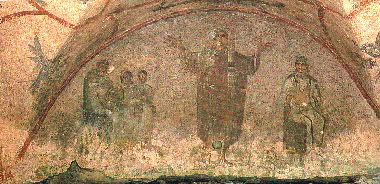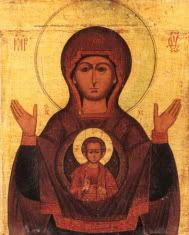
When the celebrant at Mass (a priest or bishop) offers prayer on behalf of the assembly, it is the custom that he raises his hands in the orans position, pictured above. The posture is not meant to be used by everyone together as one often sees in charismatic circles, but by one who is offering prayer for others. The 1917 Catholic Encyclopedia also notes:
Among the subjects depicted in the art of the Roman catacombs, one of those most numerously represented is that of a female figure with extended arms known as the Orans, or one who prays. The custom of praying in antiquity with outstretched, raised arms was common to both Jews and Gentiles; indeed the iconographic type of the Orans was itself strongly influenced by classic representations. But the meaning of the Orans of Christian art is quite different from that of its prototypes.

Numerous Biblical figures, for instance, depicted in the catacombs—Noah, Abraham, Isaac, the Three Children in the Fiery Furnace, Daniel in the lions' den—are pictured asking the Lord to deliver the soul of the person on whose tombs they are depicted as He once delivered the particular personage represented. But besides these Biblical Orans figures, there exist in the catacombs many ideal figures (153 in all) in the ancient attitude of prayer, which are to be regarded as symbols of the deceased's soul in heaven, praying for its friends on earth.


Left: A Christian figure in the orans pose from the Catacombs of the Via Latina in Rome, 4th century.
One of the most remarkable figures of the Orans cycle, dating from the early fourth century, is the Blessed Virgin interceding for the friends of the deceased. Directly in front of Mary is a boy, not in the Orans attitude and supposed to be the Divine Child, while to the right and left are monograms of Christ.

Imagine offering the litany of the saints ("Holy N., pray for us") in the catacombs surrounded by images of the Orans over Christian tombs.
ReplyDeletePerhaps the iconography of the "Y" shaped orphreys on the chasuble(meant to strenghten the garment) is to represent the orans position.
ReplyDeleteCan you tell me where you found the image of Mary with Christ praying inside her? It is very powerful.
ReplyDeleteThank You